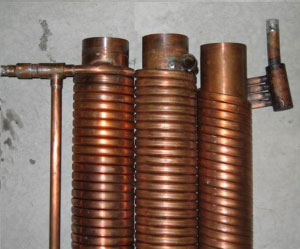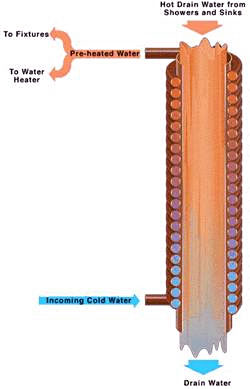 Here are three of the DWHR devices tested, showing the
Here are three of the DWHR devices tested, showing the
headers: Left to right, the Retherm S3-60, GFX G3-60,
and PowerPipe S3-60. Credit: Charles ZaloumI don't think there is one big solution to our energy problems and the environmental problems related to the use of fossil fuels--there are lots of little solutions that in the end add up to a big solution.One of those little solutions I have been reading a lot about lately is a Drain Water Heat Recovery Device (DWHR). It looks like part of something you would find hidden in the hills and hollows of Appalachia that makes moonshine, but a DWHR device is a simple copper coil that you put around your shower drain that recovers some of the heat from your shower water. Cold water is circulated through the coils, gets heated by the drain water, and then flows into your hot water tank, or into your shower and hot water tank.The device is simple, effective, and doesn’t require much (like, no) maintenance. Drain water heat recovery devices contribute to large energy savings in laundries and in multifamily buildings, but will also work very well in single-family homes--as long as there is room under the showers. My one-story house in Walnut Creek is not a good candidate for such a device.
 The simple workings of a drain water heat recovery device.
The simple workings of a drain water heat recovery device.
Credit: gfxstar.ca, Inventroment Energy Solutions.Canadian researchers from Natural Resources Canada tested the effectiveness of several DWHR devices at the Canadian Centre for Housing Technology. For an Ottawa household in which four people each take 12 minutes showers every day, a DWHR will save $150 a year in energy costs (at present, Canadian dollars are about equivalent to U.S. dollars). That's about three times as much energy saved as the energy used to run an energy-efficient 20-cubic-foot refrigerator for a year. Over the 30-year lifetime of the DHWR, which costs about $800 including installation, the device will save the household close to $3,000.The Canadian researchers created a Web-based Drain Water Heat Recovery-Energy Savings Calculator where building contractors, plumbers, and homeowners can go to estimate the cost effectiveness of several DWHR devices on the market. You just need to know the model of the device, the temperature of your shower water, estimated shower times, and so on. Right now it is set to work for Canadian locations. For U.S. homeowners, you have to pick a city in Canada. The calculator will be updated as newer technology is developed and tested.
Here are some Web sites where you can find out more about DWHR devices that were submitted for testing at the Canadian Centre for Housing Technology:
- Power Pipe www.renewability.com
- ECO-GFX www.gfxstar.ca
- Retherm www.retherm.com
If a million households in the United States installed DWHR devices, we’d save a collective $150 million in annual energy costs, or about the equivalent of 1.25-billion kWh of electricity--or a ginormous amount of carbon dioxide in air from the natural gas not burned and electricity not generated.
![]() Jim Gunshinan is Managing Editor of Home Energy Magazine. He holds an M.S. in Bioengineering from Pennsylvania State University, State College, Pennsylvania, and a Master of Divinity (MDiv) degree from University of Notre Dame.
Jim Gunshinan is Managing Editor of Home Energy Magazine. He holds an M.S. in Bioengineering from Pennsylvania State University, State College, Pennsylvania, and a Master of Divinity (MDiv) degree from University of Notre Dame.
